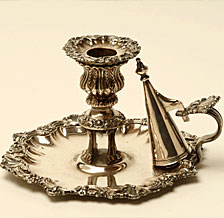

| Home | Restoration | FAQs | About Us | Customer Service |
Custom Design |
Silver Care | Silver 101 |
Silver Sales | ||||||||||


 Britannia:
A silver-white alloy composed largely of tin hardened with copper and
antimony. Closely akin to pewter, yet differing in the higher proportion
of tin, the addition of antimony and the omission of lead, resulting
in a more silvery appearance. Often contains a small quantity of zinc.
A common proportion is 140 parts tin, 3 of copper, and 10 of antimony.
Britannia:
A silver-white alloy composed largely of tin hardened with copper and
antimony. Closely akin to pewter, yet differing in the higher proportion
of tin, the addition of antimony and the omission of lead, resulting
in a more silvery appearance. Often contains a small quantity of zinc.
A common proportion is 140 parts tin, 3 of copper, and 10 of antimony.
Oxidizing: Accented beauty of ornamentation by the application
of an oxide, which darkens metal wherever applied. Shadows and highlights
are created, which give depth and character.
Patina: A soft luster caused by tiny scratches that come with
daily use.
Alloy: A substance composed of two or more metals intimately united,
usually intermixed when molten.
Bleeding: The technical term applied to pieces of plate whereon
the copper base is exposed.
Sponging or Brush Plating: A technique where plating an area
is possible without submerging the entire piece in a plating tank. This
process allows us to touch up an area where a repair has been made,
without re plating the entire piece. This process is also referred to
as ragging.
Sterling Silver: 925/1000. An alloy of Silver and copper made
up with .925 parts silver, and .075 parts copper. This was established
as the legal standard for Silver in 1238. In 1300, the requirement for
the use of a hallmark was introduced by Edward I to prevent fraud.
Coin Silver: 900/1000. 900 parts Silver, and 100 parts copper.
Used by early silversmiths to whom Sterling was not available.
Sheffield Plate: True Sheffield plate was produced by fusing,
with intense heat, a thin sheet of silver to one or both sides of a
thick sheet of copper. Invented by Thomas Boulsover in approximately
1743. Also known as Old Sheffield Plate, to distinguish it form electroplate.
 Repousse:
Translates to pushed out. Relief ornament hammered form the upper or
inner side of the metal. Gives an added sharpness of form by surface
chasing of detail and outline. Introduced to the United States by Samuel
Kirk in 1828.
Repousse:
Translates to pushed out. Relief ornament hammered form the upper or
inner side of the metal. Gives an added sharpness of form by surface
chasing of detail and outline. Introduced to the United States by Samuel
Kirk in 1828.
Epergne: An often ornate tiered centerpiece consisting typically
of a frame of wrought metal (as silver or gold) bearing dishes, vases,
or candle holders or a combination of these.
